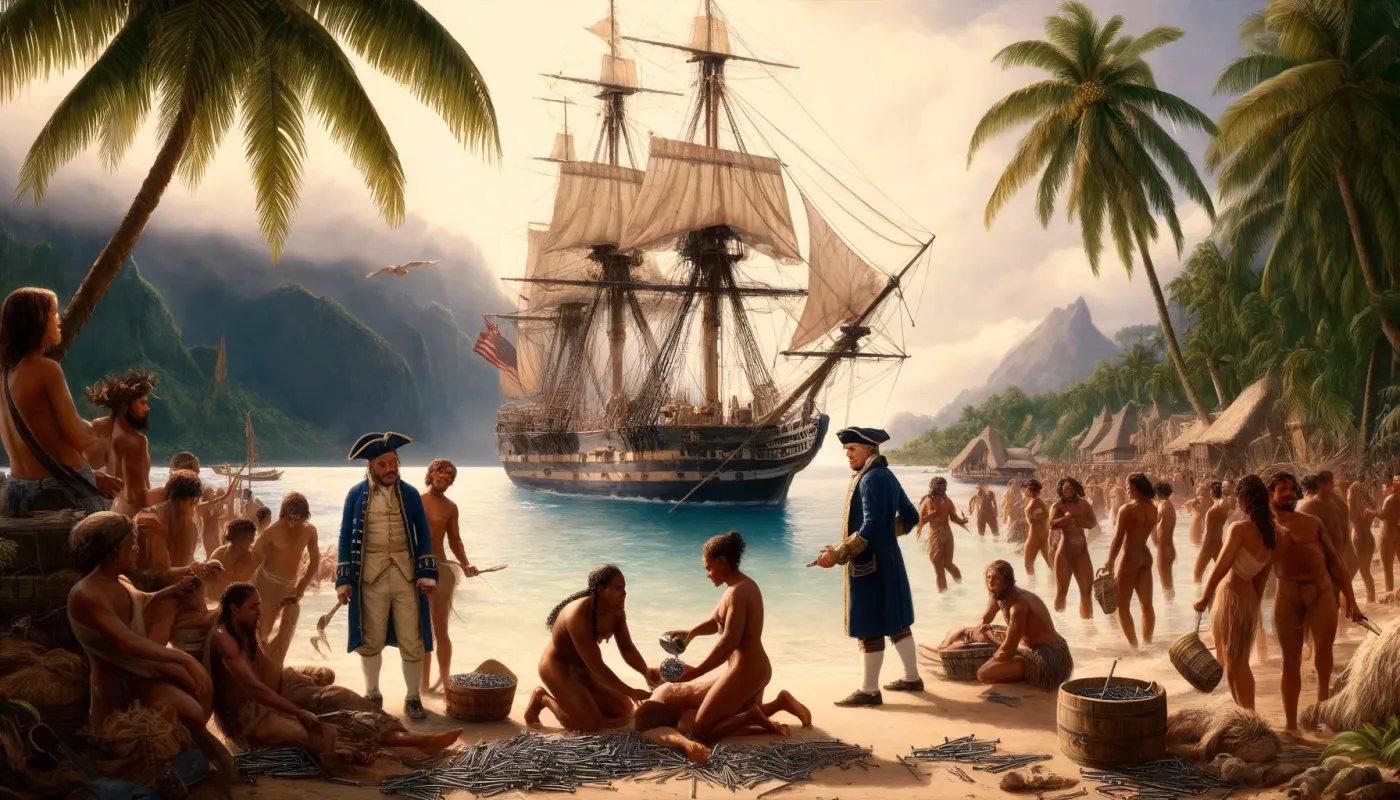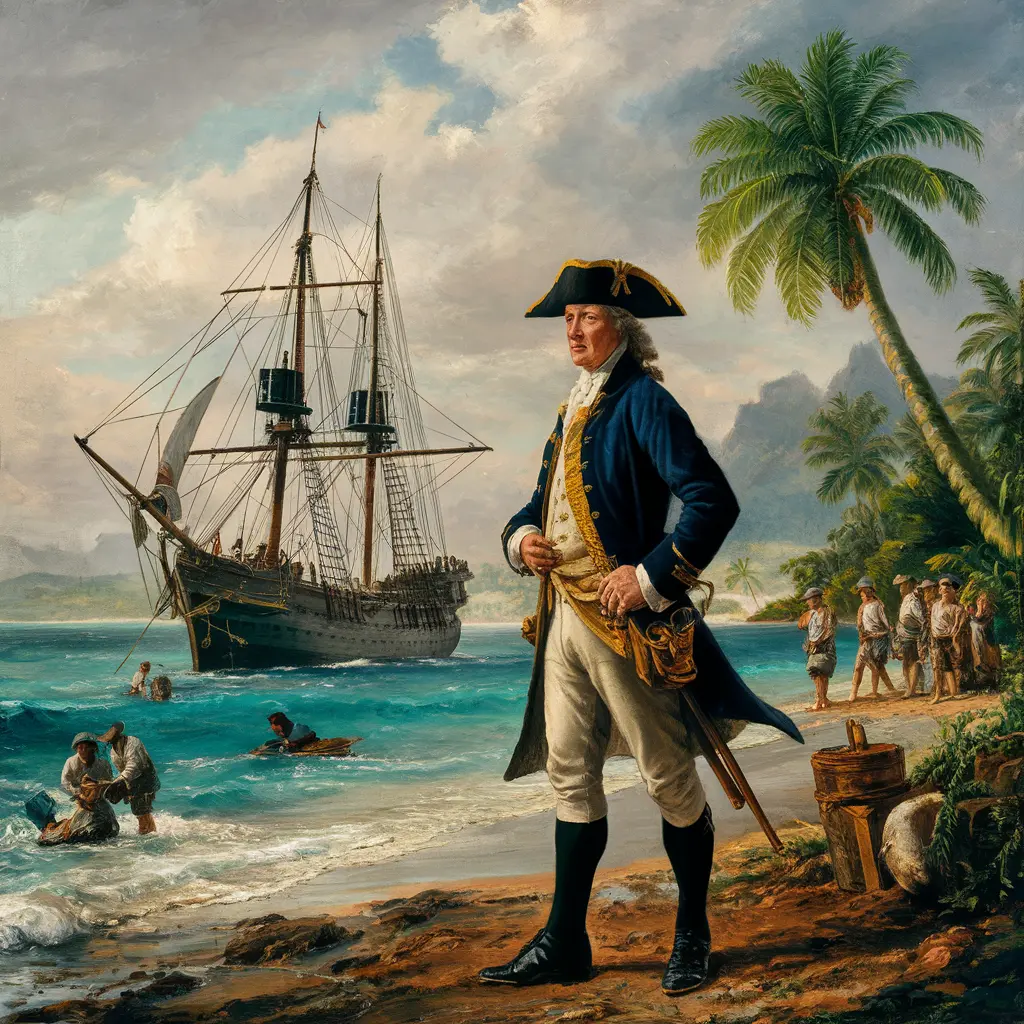How Sailors Trading Nails for Sex Ended in the Death of Captain Cook

Imagine being a young sailor, stranded on a ship for months at a time, sailing across vast oceanic expanses with nothing but ocean as far as the eye can see. The loneliness and deprivation of life at sea during the Age of Exploration took its toll on even the most hardened mariners. So when at last their ships dropped anchor at the tropical paradise of Tahiti, the temptation proved too much for many to resist.
The infamous practice of exchanging metal nails for sexual favors with the islanders soon became an open secret among European voyagers in the Pacific - a tantalizing release from the rigid confines of the ship's austere codes of conduct.
It wasn't just a one-time fling – this exchange became a pattern during the Age of Exploration as European voyagers encountered Pacific island cultures. And the consequences were sometimes deadly.
Trouble on the HMS Dolphin
In 1767, Captain Samuel Wallis and his crew on the HMS Dolphin arrived in Tahiti. The islanders were fascinated by iron nails, which were rare and far more durable than their stone tools. Seizing the opportunity, the thirsty sailors began trading these coveted nails for intimate favors with local women. It got so out of hand that they started removing nails from the ship itself, jeopardizing its seaworthiness! Wallis had to step in to prevent further structural damage – a shocking glimpse into how far these men would go to satisfy their urges.
The allure of Tahitian beauties cast a spell over sailors deprived at sea for months. With their tanned skin, floral adornments, and uninhibited approach to intimacy, the Tahitian wahines struck a sharp contrast to the puritanical European standards back home. Little wonder many crewmen willingly risked punishment to indulge their desires on these mythical islands of paradise.
HMS Endeavour (1768-1771)

The trouble on the HMS Dolphin was just the tip of the iceberg. During Captain James Cook's first voyage, the practice of trading nails for sex with Tahitian women caused significant concern. While it did not compromise the ship's structural integrity to the same extent as with HMS Dolphin, it raised moral and disciplinary issues among the crew. Cook had to take measures to curb the practice to maintain order and discipline aboard the ship.
HMS Resolution and HMS Discovery (1776-1780)
On Cook's third voyage, the trade of metal items for sexual favors continued. This time, the interactions led to more severe consequences. In Hawaii, during their second visit, the increased tension and misunderstandings with the locals eventual let to the murder of Captain Cook in 1779.

The exchanges of goods, including metal items, created conflicts and misunderstandings that escalated the situation, although the immediate cause of Cook's death was a clash over the theft of a boat, and some historians argue that tragedy wouldn't have happened if not for the build-up tension over the islanders' women.
Mutiny on the Bounty (1789)
The infamous mutiny on HMS Bounty, led by Fletcher Christian against Captain William Bligh, had indirect links to the interactions with Tahitian society. The sailors had formed relationships with Tahitian women and experienced a relatively idyllic lifestyle during their extended stay. This created a stark contrast to the harsh conditions aboard the ship and Bligh's strict discipline, contributing to the mutiny. After the mutiny, some of the mutineers returned to Tahiti, where conflicts eventually arose between them and the local population.
European Whalers and Traders (18th and 19th centuries)
The ongoing trade of metal items and other goods for sexual favors by whalers and traders in the Pacific Islands led to numerous problems. These interactions often resulted in the spread of sexually transmitted diseases, which had devastating effects on the indigenous populations. Additionally, the practice disrupted local social structures and norms, leading to long-term societal changes and tensions.
So while botanical expeditions and geographic discoveries get all the glory, the Age of Exploration had a seedier underbelly of debauchery, exploitation, and deadly misunderstandings. Who knew a few nails could lead to such shocking scandals?
A Well-Documented Phenomenon
The exchange of metal goods, particularly nails, for sexual favors in the Pacific Islands is a well-documented phenomenon. Numerous historical records and journals from European explorers provide detailed accounts of these interactions. Captain Samuel Wallis of the HMS Dolphin and Captain James Cook of the HMS Endeavour both noted such exchanges in their logs.
Captain Wallis's observations during the HMS Dolphin's visit to Tahiti in 1767 are well-recorded in maritime history. Similarly, Captain Cook's journals from his voyages (1768-1771, 1772-1775, and 1776-1779) extensively describe the trading practices between his crew and the Tahitians, as well as other Pacific Islanders. Cook's detailed documentation can be found in "The Journals of Captain James Cook on his Voyages of Discovery" edited by J.C. Beaglehole.
Moreover, the mutiny on the HMS Bounty in 1789, led by Fletcher Christian, is another well-documented case where the sailors' interactions with Tahitian women played a significant role. The events leading up to the mutiny and its aftermath are thoroughly chronicled in "The Bounty: The True Story of the Mutiny on the Bounty" by Caroline Alexander.
